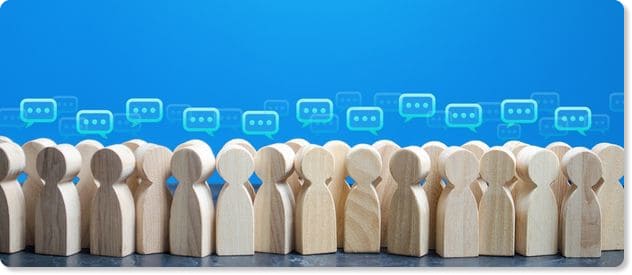What is Employee Communication? Complete Guide to Employee Comms
Getting employee communication right is critical to a company’s success. In this guide, you’ll learn everything you need to know about employee comms for the modern workforce.
What is the meaning of employee communication?
Employee communication refers to the two-way communication between a company and its employees. It can also refer to the communication between employees and managers. Employee comms is also called internal communication.
Employee communication includes all types of communication that happen within a company:
- Top-Down. This is the communication that comes from the executive team and is pushed down through the company. Often, companies rely on cascading communication, where messages trickle down through management levels until messages reach hourly or entry-level employees.
- Middle-Out. This is all communication that is shared by mid-level managers with their teams. It happens when you empower these managers to communicate regularly, rather than waiting for messages from the top. When you encourage middle-out communication, you tend to improve two-way communication by making open, transparent comms embedded in the daily culture.
- Bottom-Up. This is when the employee voice is amplified and communication travels from the hourly or frontline teams up through the company.

Why is employee communication important?
Strong communication is foundational to a company’s success. It is how:
- Business objectives are communicated from the top-down
- Companies receive employee feedback to improve the employee experience
- Managers are able to manage and support their teams
Effective communication also helps companies build trust and manage change effectively. Since so much relies on employee comms that improving it has become a key focus of businesses.
Who is responsible for communicating with employees?
Typically, there is a team of communication professionals within a company that oversees employee comms (also called internal comms or corporate comms).
Sometimes, this function rolls into Human Resources and is managed by a dedicated HR Communications professional. Company communication is often overseen by a Chief Communications Officer, who manages both internal and external communications for the company.
Companies may also have communications champions. These are employees who are highly engaged and active. Internal comms teams tap these employees to help communicate key initiatives to help with change management, employee engagement, and the localization of content.

What are the top barriers to effective communication?
Gallup research has found that 70% of the variance in employee engagement comes down to the manager. But Gatehouse research has found that the lack of manager communication skills is a top challenge facing companies.
Poor line manager communication skills are one of the largest barriers to effective employee communication at most companies. If those companies don’t have a direct way of reaching frontline employees, they are forced to rely on the cascade of comms through the chain of management. This is often like a game of telephone where messages get lost in translation, the importance of the message gets left out, and the tone of managers can vary drastically, which leaves companies without much control of the message and no way of measuring the impact.
Other key barriers to effective employee comms include:
- A lack of budget to afford adequate headcount or the right employee communication tools.
- Comms teams that are too small, which makes it difficult to make time for certain key tasks like gathering employee feedback or measuring campaign and content performance.
These resource limitations severely restrict the ability to execute a strong employee comms plan.
What are the top employee communication trends?
There are three key trends we are seeing in employee communication right now: employee listening, employee engagement, and focusing on the employee experience.
Employee Listening
Employee listening is the practice of listening to employee sentiment, needs, concerns, and wants. Many companies already invest heavily in customer listening as part of their focus on the customer experience (CX).
But there is a clear link between employee experience (EX) and CX, which has put the spotlight on improving the overall employee experience.
One of the key ways this is being done is by investing in employee listening tools and tactics, such as employee surveys, to more accurately measure what employees are saying, thinking, feeling, and doing.
Employee Engagement
Employee engagement refers to how an employee feels about their work and their level of commitment and involvement in that work. This metric is a precursor to all kinds of other business outcomes like retention, productivity, safety and compliance, job satisfaction, and more.
It is one of the top concerns of many companies because of the correlation between high engagement and other KPIs. And it’s recognized that strong communication can help:
- Improve engagement by showing employees they are valued
- Connect what employees do every day to the larger goals and work of the company
- Help managers be better leaders and communicators
Employee Experience
Employee experience is the focus on improving the overall experience of employees at your company. This journey starts in the hiring process, through onboarding, and development, until an employee exits the company. Every stage of this process is fundamental in building culture and brand reputation.
Strong communication is key to building a positive experience for all employees. But with 80% of the workforce not sitting behind a desk and more deskbound employees becoming remote, there is a huge shift to focus on the digital employee experience and communicating with remote employees.

How do you create an employee communication strategy?
Creating an effective employee communication plan relies on focusing on a few key areas, including content strategy, campaign planning, employee listening, and leadership communication.
- Audit Employee Communications. Before an internal communications professional should begin planning content and campaigns, they need to conduct an internal comms audit to understand what employee groups have access to what channels and what messages.
- Survey Employees. We also recommend conducting regular employee surveys to learn what channels employees use or would use if they had access. Use these surveys to learn what the best medium for sharing information is (e.g. video vs. an employee newsletter). Focus groups can also help you test out new channels and content mediums before sharing them with everyone.
- Build an Editorial Calendar. Once you understand your audiences, channels, and messages, plan your content strategy and create campaigns that achieve your business objectives. Using an editorial calendar can help you plan these campaigns and get ahead.
- Measure and Iterate. A strategy doesn’t end with content being pushed out to employees. We need to constantly be measuring our campaigns, channel metrics, and KPIs to keep moving in the right direction. This enables us to make changes to our content and tactics in real-time.
How do you improve employee comms?
In order to improve, you need to understand where the pain points are in your current strategy.
- Do your employees have access to the right information they need to do their jobs?
- Are your frontline managers struggling to keep up with everything they are expected to communicate?
- Do your employees feel disconnected from the leadership team or the company at large?
- Do you have a culture problem that’s causing employees to disengage?
Surveying your employees regularly and creating a focus group are great ways to start narrowing down what elements of employee comms you need to focus on.
How does theEMPLOYEEapp help with employee comms?
theEMPLOYEEapp is a mobile employee communication solution designed to help companies more effectively reach their frontline, hybrid, and remote employees.
These employees often have few direct channels for communication with corporate or senior management. This often fosters disengagement and a lack of clarity around the company’s vision, mission, and purpose.
When employees feel that their voice isn’t being heard or that their feedback isn’t sought out, they don’t feel valued.
theEMPLOYEEapp helps solve this problem by creating a direct channel for employee communication, including top-down messaging, surveys, a company directory, and key resources all in one central hub.

